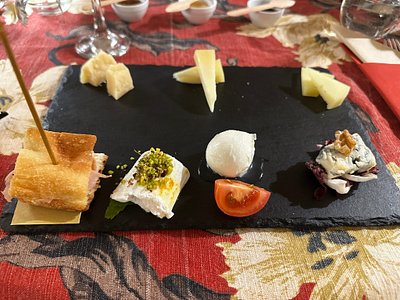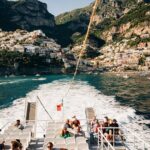Rome Tiber River Cruise and Top Food Tasting with Wine Pairing
Overview
Rome Boat Tiber River Hop On Hop Off ride, including an Exclusive Food Tasting and wine pairing in a Roman cistern from the 1st century AD. Discover the most secret wine cellar in the heart of Trastevere, in an authentic Roman cistern from the 1st cent. AD. Enjoy some traditional Italian delicacies paired with a selection of excellent wines.
Take a Hop On Hop Off cruise on the Tiber River, and let yourself be cradled and experience a moment, immersing yourself in the tranquility that this place can give you. Once on board, head towards the Tiber Island from Castel Sant'Angelo. You will cross the historic center of Rome and admire some monuments and iconic places of the eternal city from a privileged and unique point of view. Once you reach Fabullus Winery, live and share an experience in which food and wine balance each other in a perfect combination of tastes.
The menu includes seasonal products all Slow Food* presidium certified by the DOC DOCG IGT, DOP, IGP, and STG brands.
What's Included
- Presentation and explanation by our expert staff
- 1 Glass of Prosecco, 4 Glasses (2 White & 2 Red) Superior Italian wines selected by our Expert staff
- 4 types of olive 3 qualities of bread Extra virgin olive oil Roman Pizza (Focaccia)
- Water or soft drinks at Fabullus Wine Cellar
- Honey and jams to pair with cheeses Ice Cream/Tiramisù (or other Italian Typical Dessert) & Coffee
- Mortadella with pistachio, buffalo mozzarella, ricotta, fresh vegetables or in oil or vinegar, etc.)
- 3-course tasting (Selection of fresh and mature cheeses, various types of cured meats, ham)
- Cruise 24-Hour Ticket to the hop-on, hop-off Tiber River boat
- Hotels Pick Up & Drop Off
- On the River boat not Tour guide service
- Gratuities, Tour Guide, Baby seats.
What To Expect
St. Angelo Bridge
10 minutes • Admission Ticket Free
Museo Nazionale di Castel Sant'Angelo
10 minutes • Admission Ticket Free
St. Peter's Basilica (Pass By)
Ponte Vittorio Emanuele II (Pass By)
Ponte Principe Amedeo Savoia Aosta (Pass By)
Trastevere (Pass By)
Campo Marzio (Pass By)
Colle del Gianicolo (Pass By)
Ponte Sisto
5 minutes • Admission Ticket Free
Pont Fabricius
10 minutes • Admission Ticket Free
Ponte Cestio (Pass By)
Isola Tiberina
10 minutes • Admission Ticket Free
Fabullus Wine Cellar
1 hour • Admission Ticket Included
Additional Info
- Public transportation options are available nearby
- Not recommended for Wheelchairs Users and people with Mobility impairments
- Vegans Only on request if available | Not recommended for diabetics
- Not recommended for diabetics
- Not recommended for children under 7
- Hotel Pick up and Drop off not included
- Travelers should have at least a moderate level of physical fitness
- Any time not allocated in the itinerary will be spent moving between stops. We recommend that you read the information on your booking voucher carefully.
- NOTE! The booked time refers to the start of the food and wine tasting at the Wine Cellar Fabullus, and NOT to the start of the cruise on the Tiber River.
- The cruise on the Tiber River is a hop on hop off service and the food tasting with wine pairing is held at the Fabullus Wine Cellar
- When booking, it is mandatory to communicate any allergies or intolerances to food and drinks.
- For the Food Tasting with Wine Pairing experience, it is suggested that you get off the boat at the pier of the Tiber Island, which is only 700 meters from the Wine Cellar.
- The River Cruise Hop on Hop Off ticket is valid 24 hours from the first embarkation (Hop on, Hop Off). Cruises run every day between 10 a.m. and 6 p.m.
- Your ticket is valid for 24 Hours for any departure from 4 stops: 1. Isola Tiberina: Lungotevere Degli Anguillara side 2. Angelo Bridge: Lungotevere Tor Di Nona side 3. Justice Palace: Lungotevere Marzio 4. Popolo Square: Lungotevere In Augusta
- When booking, it is mandatory to communicate any allergies or intolerances to food and drinks.
- Fabullus and the staff are not responsible for any reactions caused by allergies or intolerances to food and drinks if not communicated before the service.
- Punctuality is required to fully enjoy the experience. For delays exceeding 20 minutes the tasting could be canceled.
- When booking, it is mandatory to communicate a valid phone number to be contacted once you are in Italy
- This tour/activity will have a maximum of 20 travelers
Frequently Asked Questions
(8)Q: Will I get seasick on Rome Tiber River Cruise and Top Food Tasting with Wine Pairing?
Cancellation Policy
Still have questions?
We're here to help.
Activity code: C-468103P1
Traveler Photos





Reviews
Average 4.33 out of 5 stars based on 24 traveler reviews collected by City Boat Tours and partner sites such as Cool Destinations and TripAdvisor
Additional Info
Similar Tours & Activities

Exclusive All Inclusive Pompeii and Wine Tasting Private Tour
US$1,361.21

Rome Villa Borghese Lake Rowing Boat Tour and Aperitif
US$93.59

Pompeii SkipTheLine with Lunch&WineTasting from Rome
US$782.12

Sorrento and Pompeii Skip-The-Line Full-Day from Rome
US$1,006.99
Travelers Who Bought This Tour Also Bought

Pasta Cooking Class in Rome - Fettuccine Class in Piazza Navona
US$61.62

Early Vatican Museums Tour: The Best of the Sistine Chapel
US$105.47

Skip the Line: Vatican Museum, Sistine Chapel + Optional Basilica
US$65.53

Best of Rome Walking Tour including Trevi Fountain
US$4.50









